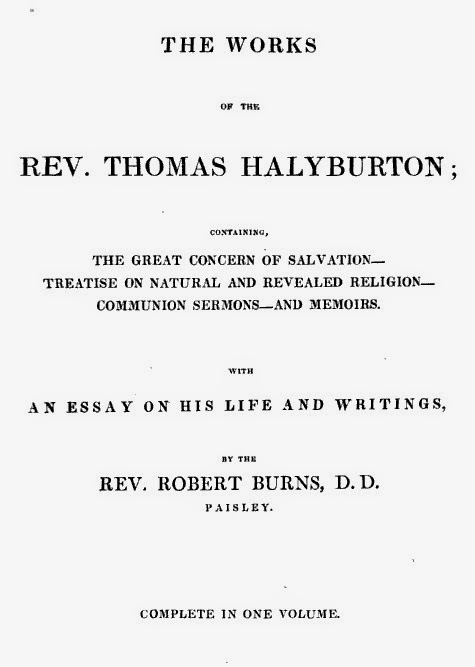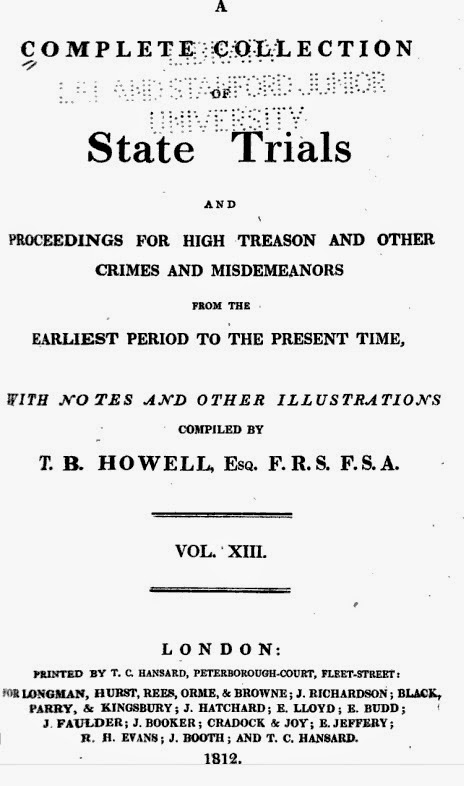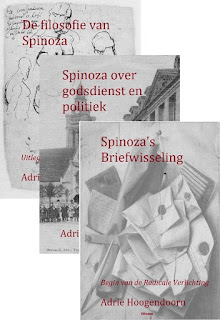Thomas Aikenhead (1676 – 1697) was de laatste in Groot-Brittannië voor blasfemie ter dood veroordeelde. Had Spinoza hem op z’n ideeën gebracht?
 Thomas Aikenhead was een Schots student uit Edinburgh die op
20-jarige leeftijd veroordeeld en ter dood gebracht werd, nadat hij er openlijk
voor uitgekomen was de bijbel "a rhapsody of ill-invented nonsense"
te vinden ["so stuffed
with maddness, nonsense, and contradiction, that you admired the stupidity of
the world in being so long deluded by them."]. Op 8 januari 1697 werd
Thomas Aikenhead ter dood gebracht - de laatste die in Groot-Brittannië voor
godslastering werd verhangen [nl.wiki
cf ook en.wiki].
Had hij zijn godslasterlijk bevonden ideeën bij Spinoza opgedaan? In ieder
geval bevatte de Universiteitsbibliotheek boeken van Descartes, Spinoza, Thomas
Hobbes en andere zgn. atheïsten. [Cf. en
cf.]
Thomas Aikenhead was een Schots student uit Edinburgh die op
20-jarige leeftijd veroordeeld en ter dood gebracht werd, nadat hij er openlijk
voor uitgekomen was de bijbel "a rhapsody of ill-invented nonsense"
te vinden ["so stuffed
with maddness, nonsense, and contradiction, that you admired the stupidity of
the world in being so long deluded by them."]. Op 8 januari 1697 werd
Thomas Aikenhead ter dood gebracht - de laatste die in Groot-Brittannië voor
godslastering werd verhangen [nl.wiki
cf ook en.wiki].
Had hij zijn godslasterlijk bevonden ideeën bij Spinoza opgedaan? In ieder
geval bevatte de Universiteitsbibliotheek boeken van Descartes, Spinoza, Thomas
Hobbes en andere zgn. atheïsten. [Cf. en
cf.]
De Duitse wikipedia geeft méér: “Im November 1696 wurde
Aikenhead wegen Gotteslästerung angeklagt. Fünf ehemalige „Freunde“ und
Mitstudenten sagten als Zeugen gegen ihn aus. Sie berichteten, dass Aikenhead
u. a. die folgenden Äußerungen gemacht habe:
- Theologie sei eine Schwärmerei („rhapsody“)
von schlecht erfundenem Unsinn;
- Gott, die Welt und die Natur seien ein und
dasselbe (wörtlich: „are but one thing“), und die Welt habe seit
Ewigkeit bestanden;
- das Christentum sei bald völlig
verschwunden, wahrscheinlich schon im Jahr 1800;
- das Alte Testament nenne er „Esras Fabeln“, in Anspielung auf Äsops Fabeln und darauf, dass Esra das Alte Testament erfunden habe;
- Jesus sei ein Betrüger-Messias (wörtlich: „impostor
Christ“) gewesen und habe mit in Ägypten erlernter Magie seine Jünger,
eigentlich unverständige Fischer, hinters Licht geführt;
- die Trinität sei unglaubhaft und ihrer Widerlegung nicht
wert;
- der Glaube an eine gleichzeitig göttliche
und menschliche Natur Jesu sei so absurd wie der Glaube an ein rundes
Quadrat oder an einen „hircus cervus“, ein Tier, das halb
Ziegenbock, halb Hirsch sei;
- die Bibel enthalte so viele Widersprüche wie
Seiten.
Mit einigen dieser Ansichten zeigt sich Aikenhead von
Spinoza beeinflusst, so von dessen Annahme eines weltimmanenten Gottes, der mit
der Natur identisch sei („deus sive natura“: Spinoza, Ethica IV, praefatio); auch die Ansicht,
Esra habe das Alte Testament in großen Teilen geschrieben, geht auf Spinoza
zurück (Tractatus theologico-politicus,
Kapitel 8). [de.wiki]
De eerste die de relatie met Spinoza legde was Thomas
Halyburton (1674 – 1712), hoogleraar theologie aan de St. Andrew's University. Gedurende einige tijd was hij studiegenoot van Thomas Aikenhead geweest en zelf had hij regelmatig ook
zo zijn twijfels gehad, maar die hield hij voor zich [cf. hierna het boek van Michael
F. Graham, cf ook het Ref. Dagblad].
 Halyburton‘s boek Natural religion insufficient, and revealed necessary to man's
happiness in his present state (posthuum verschenen in 1714) had ten doel deïsme
en atheïsme te bestrijden en de geopenbaarde godsdienst te verdedigen, o.a.
door de grenzen van de menselijke rede m.b.t. de fundamentele waarheden van
godsdienst en moraal aan te geven. Hij bepleitte het onderdrukken van alle ideeën
die gevaarlijk waren voor het christendom en met name noemde hij Hobbes,
Spinoza en anderen van gelijke aard die geen geringe invloed uitoefenden op
"a great vogue amongst our young gentry and students, whereby many were
poisoned with principles destructive of all true religion and morality."
Voorts critiseerde Halyburton Aikenhead en legde een directe relatie tussen
diens "blasphemies" met zienswijzen van Hobbes en Spinoza. [cf. books.google]
Halyburton‘s boek Natural religion insufficient, and revealed necessary to man's
happiness in his present state (posthuum verschenen in 1714) had ten doel deïsme
en atheïsme te bestrijden en de geopenbaarde godsdienst te verdedigen, o.a.
door de grenzen van de menselijke rede m.b.t. de fundamentele waarheden van
godsdienst en moraal aan te geven. Hij bepleitte het onderdrukken van alle ideeën
die gevaarlijk waren voor het christendom en met name noemde hij Hobbes,
Spinoza en anderen van gelijke aard die geen geringe invloed uitoefenden op
"a great vogue amongst our young gentry and students, whereby many were
poisoned with principles destructive of all true religion and morality."
Voorts critiseerde Halyburton Aikenhead en legde een directe relatie tussen
diens "blasphemies" met zienswijzen van Hobbes en Spinoza. [cf. books.google]
 Het leggen van dit verband was zo invloedrijk dat toen in
1812 in Volume 13 van Cobbett's Complete
Collection of State Trials and Proceedings for High Treason and Other Crimes
and Misdemeanors from the Earliest Period to the Present Time, door Thomas
Bayly Howell, Thomas Jones Howell, William Cobbett & David Jardine, waarin ook
de processtukken van de zaak Thomas Aikenhead onder William III voor het eerst gepubliceerd
werden, aan het eind ervan een uitgebreid citaat uit dat boek van Thomas
Halyburton werd toegevoegd, alsof de samensteller daardoor die besmetting van Aikenhead
door Hobbes en Spinoza wilden bevestigen. [Cf. books.google]
Het leggen van dit verband was zo invloedrijk dat toen in
1812 in Volume 13 van Cobbett's Complete
Collection of State Trials and Proceedings for High Treason and Other Crimes
and Misdemeanors from the Earliest Period to the Present Time, door Thomas
Bayly Howell, Thomas Jones Howell, William Cobbett & David Jardine, waarin ook
de processtukken van de zaak Thomas Aikenhead onder William III voor het eerst gepubliceerd
werden, aan het eind ervan een uitgebreid citaat uit dat boek van Thomas
Halyburton werd toegevoegd, alsof de samensteller daardoor die besmetting van Aikenhead
door Hobbes en Spinoza wilden bevestigen. [Cf. books.google]
 Michael F. Graham, The
Blasphemies of Thomas Aikenhead: Boundaries of Belief on the Eve of the
Enlightenment [Edinburgh University Press, 2008 – books.google
– book review] is het eerste
hedendaagse boek over de zaak Thomas Aikenhead die de auteur plaatst in de context van
de toenmalige transitie die de confessionele wereld sinds de Reformatie
doormaakte en waarin de sterke behoefte gevoeld werd om het orthodoxe geloof te
verdedigen tegen de vrijdenkers van de Radicale Verlichting. Aikenhead werd het
slachtoffer van die angst van de ‘presbyterian ministers' over de richting die
de intellectuele veranderingen uitgingen.
Michael F. Graham, The
Blasphemies of Thomas Aikenhead: Boundaries of Belief on the Eve of the
Enlightenment [Edinburgh University Press, 2008 – books.google
– book review] is het eerste
hedendaagse boek over de zaak Thomas Aikenhead die de auteur plaatst in de context van
de toenmalige transitie die de confessionele wereld sinds de Reformatie
doormaakte en waarin de sterke behoefte gevoeld werd om het orthodoxe geloof te
verdedigen tegen de vrijdenkers van de Radicale Verlichting. Aikenhead werd het
slachtoffer van die angst van de ‘presbyterian ministers' over de richting die
de intellectuele veranderingen uitgingen.
In bovenvermelde Proceedings werd ook Thomas Aikenhead laatste brief opgenomen die hij op de dag van zijn terechtstelling vanuit de gevangenis Edinburgh Tolbooth (op de cover te zien) aan zijn vrienden schreef. Die neem ik hier op ter herdenking van dit slachtoffer van de Verlichting. Deze overheidsmoord bewijst hoe nodig het pleidooi voor Libertas Philosophandi was. Onvoorstelbaar dat een jongeman eenvoudig om zijn vrije ideeën kon worden gedood.

____________
Zie ook Alasdair Raffe, The Culture of Controversy: Religious Arguments in Scotland, 1660-1714. Boydell Press, 2012 - books.google
Arthur Herman, How the Scots Invented the Modern World. Crown Publications, 2002 - heeft het verhaal over de vervolging van Thomas Aikenhead centraal en uitgebreid in de Preface - te lezen bij Amazon
 * * *
* * *
Zelden of nooit neem ik een complete tekst over, maar nu kan ik het niet laten deze fraaie tekst over te nemen van Dr John Gordon Course Leader of the summer programme The Scottish Enlightenment in Context [cf.]
Posted on Tuesday, December 9, 2014
On 8th January 1697 a 20-year old student at the University of Edinburgh, Thomas Aikenhead, was hanged for blasphemy. Aikenhead had been heard to state, while walking past the Tron Kirk in Edinburgh’s High Street, that theology was ‘a rapsidie of faigned and ill-invented nonsense’ (Graham p.81). A little over forty years later, David Hume’s A Treatise of Human Nature (1738) was published.
Hume includes a quotation from the ancient Roman historian Tacitus as a frontispiece to his text: Rara temporum felicitas, ubi sentire, quæ velis; & quæ sentias, dicere licet (‘The rare good fortune of an age in which we may feel what we wish and say what we feel’ (Tacitus 1.1)). Clearly Scotland had changed significantly in the forty one years between the execution of Aikenhead and the 27 year-old Hume’s completion of the first volume of his philosophical magnum opus. The all-encompassing authority of the Scottish kirk was weakening, and, as Hume’s quotation suggests, individual freedom was increasingly valorized. Hume’s Treatise is one of the early works of what has come to be known as the Scottish Enlightenment.
Sir Walter Scott captured this transformation when he later observed, in ‘A Postcript Which Should Have Been a Preface’ to his novel Waverley, that ‘there is no European nation which, within the course of half a century, or little more, has undergone so complex a change as this kingdom of Scotland’ (Scott p.363).
The transformation to which Scott alludes is social and technological as well as intellectual, and it extends across philosophy, ethics, social theory, political thought, historiography, medicine, science, aesthetics, literature, and religious thought, as well as technology. The Scottish Enlightenment is exported – most conspicuously to the United States of America, where the education system and the constitution to this day exhibit the influence of major Scottish thinkers of the period.
Just as the Scottish Enlightenment was preceded by one notorious criminal trial – that of Thomas Aikenhead – it has been suggested that it comes to an end with another: ‘the last of the victims of Burke and Hare was the Scottish Enlightenment’ (Edwards p.147). Burke and Hare were murderers, who sold the corpses of their victims to Dr Robert Knox, who used them for his Edinburgh anatomy lectures. Burke was hanged on 28th January 1829; Knox’s reputation never recovered – and the critics of Enlightenment were quick to exploit this sordid case.
From Hume’s Treatise to the anatomical studies of Knox, the ‘Science of Man’ was central to the Scottish Enlightenment. The new understanding of what it is to be a human being was to ramify across numerous areas of intellectual interest; these ramifications are still being studied in the twenty first century.
Edwards, O.D., 2014. Burke and Hare. Edinburgh: Birlinn.
Graham, M.F., 2008. The Blasphemies of Thomas Aikenhead - Boundaries of Belief on the Eve of the Enlightenment. Edinburgh: Edinburgh University Press.
Scott, W., 1814. Waverley. Edited by P.D. Garside, 2011. Harmondsworth: Penguin.
Tacitus., 109 AD. The Histories. Edited by D.S. Levene, 2008. Oxford: Oxford University Press.
Dr John Gordon Course Leader of the summer programme The Scottish Enlightenment in Context
spinoza | 05-03-2015 | 22:40 | Link |
 Thomas Aikenhead was een Schots student uit Edinburgh die op
20-jarige leeftijd veroordeeld en ter dood gebracht werd, nadat hij er openlijk
voor uitgekomen was de bijbel "a rhapsody of ill-invented nonsense"
te vinden [
Thomas Aikenhead was een Schots student uit Edinburgh die op
20-jarige leeftijd veroordeeld en ter dood gebracht werd, nadat hij er openlijk
voor uitgekomen was de bijbel "a rhapsody of ill-invented nonsense"
te vinden [
 Het leggen van dit verband was zo invloedrijk dat toen in
1812 in Volume 13 van Cobbett's Complete
Collection of State Trials and Proceedings for High Treason and Other Crimes
and Misdemeanors from the Earliest Period to the Present Time, door Thomas
Bayly Howell, Thomas Jones Howell, William Cobbett & David Jardine, waarin ook
de processtukken van de zaak Thomas Aikenhead onder William III voor het eerst gepubliceerd
werden, aan het eind ervan een uitgebreid citaat uit dat boek van Thomas
Halyburton werd toegevoegd, alsof de samensteller daardoor die besmetting van Aikenhead
door Hobbes en Spinoza wilden bevestigen. [Cf.
Het leggen van dit verband was zo invloedrijk dat toen in
1812 in Volume 13 van Cobbett's Complete
Collection of State Trials and Proceedings for High Treason and Other Crimes
and Misdemeanors from the Earliest Period to the Present Time, door Thomas
Bayly Howell, Thomas Jones Howell, William Cobbett & David Jardine, waarin ook
de processtukken van de zaak Thomas Aikenhead onder William III voor het eerst gepubliceerd
werden, aan het eind ervan een uitgebreid citaat uit dat boek van Thomas
Halyburton werd toegevoegd, alsof de samensteller daardoor die besmetting van Aikenhead
door Hobbes en Spinoza wilden bevestigen. [Cf. 
 * * *
* * * 
